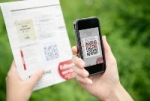Mail Meets Mobile Marketing
 | A woman sorts through her mail and finds an advertisement for her favorite clothing store. She loves the dress in the ad, but she’s not a fan of the drab color, and she’s having a hard time imagining it in a brighter hue. So, she takes out her mobile phone, points it at the picture of the dress, and suddenly she can see how it looks in yellow, orange, or red. |
| Her husband grabs the stack of mail and spots a piece advertising a resort in Jamaica. The photograph of the beach looks lovely, but he wonders if there’s more to the place than surf and sun. When he points his tablet at the advertisement, a video pops up on his screen, showing couples enjoying fine dining and dancing lessons. These are examples of augmented reality—the virtual placement of digital graphics onto objects in the physical world. And while the technology isn’t yet widely used, it’s an example of the sort of thing advertisers will need to incorporate to keep their direct mail relevant in an increasingly digital world, says Bruce Gresham, product manager at Pitney Bowes. “As digital becomes more and more accepted, not only from the younger generations, but as even older generations become larger users of technology, connecting these physical marketing messages with the digital channel will ensure that marketing campaigns are more effective,” Gresham says. “It’s the old adage: ‘You have to tell people things seven times for them to get it.’ It’s basically a new way of doing that, and speaking to people how they want to receive the message.” Gresham stresses that the physical nature of direct mail remains an important aspect. Marketing emails can be caught up in spam filters, ignored by their recipients, or mistaken for scams, and it only takes a couple of clicks for people to unsubscribe from digital mailing lists. Physical mail, by contrast, demands more engagement from the recipient. In surveys, three quarters of people say they like to see what’s in the mail, and 63 percent of physical mail is kept for at least two days. “People still spend time with their mail every day, pulling it out of the box, sorting it,” Gresham says. “It’s still a habit that’s ingrained in most people.” While email and online bill-pay have led to steady declines in first-class mail, direct mail has held fairly steady over the past two decades, accounting for around 12 percent of total advertising. But, says Gresham, advertisers who link their physical mail to the digital sphere will take advantage of an opportunity to deliver their message via another channel, reaping greater rewards in the process. Although augmented reality hasn’t yet been widely adopted, advertisers are already embedding scannable graphics like QR codes (also known as two-dimensional barcodes) and SnapTags, and also linking to digital content through Intelligent Mail barcodes. Although these technologies have only existed for a few years, Gresham says, more than 20 percent of adult Americans—and well over 40 percent of people under 34—use them. Of these, open-source QR codes are the most familiar to consumers, but the codes are also used in business processes like quality control, and people can sometimes become confused about whether they’re meant to scan the black-and-white squares or not. Proprietary SnapTags allow businesses to embed their own logos, while Intelligent Mail barcodes are already on the mail piece, meaning that advertisers who utilize them for digital marketing won’t further clutter up the mail. The United States Postal Service, Gresham notes, frequently runs promotions to encourage marketers to try these new strategies by providing postage discounts that add up to big savings quickly. Recipients use their phones or tablets to scan the graphics printed on the physical mail, and they’re then taken to a website where marketers can continue relaying their message. But, Gresham says, it’s important that the message in the digital space add value. “You’re not going to want someone to open up a mail piece, scan a QR code, and then go to a website that shows the exact same thing. Their interest in the initial offering will not only decline, but it may be totally off-putting to them.” Instead, Gresham says, the digital space should offer mail recipients something that couldn’t have been printed on a mailer—a video, for example, or the chance for a discount if they provide their email address or connect with a company through social media. Advertisers can also use personal URLs (PURLs)—which are landing pages that include a person’s name and are typically tailored to his or her demographic. Gresham notes that response rates for personalized direct mail are as much as 24-percent higher than for static direct mail. A 25-year-old might land on a page with images of a group of buddies at a ballgame, along with information about starting to save for retirement; a 40-year-old might see a family of four, with a message about home refinancing; and a page meant for a 70-year-old might feature an older couple walking along the beach and information about reverse mortgages. As important as it is to incorporate digital with direct mail, Gresham says, it shouldn’t come at the expense of a person’s experience with the physical mail itself. “You’re not going to send a piece of mail that has one sentence, and then says, ‘Scan this for more information.’ You definitely don’t want to overcrowd the mail piece with four different bar codes,” he says. “The digital message is not going to overpower that moment that they’re having with the physical mail. It’s a complement to it.” Please join Bruce Gresham to learn more on Monday, May 17 at 1:30 p.m. ET in the Chesapeake D room at National Postal Forum! | |